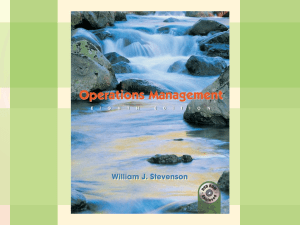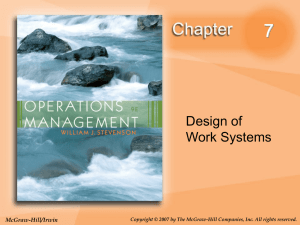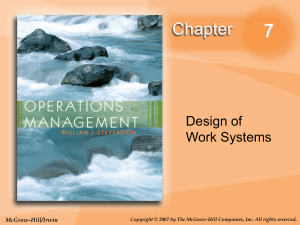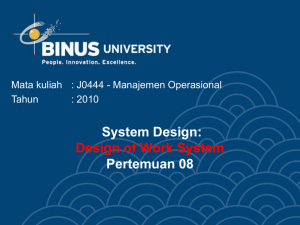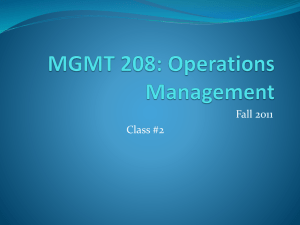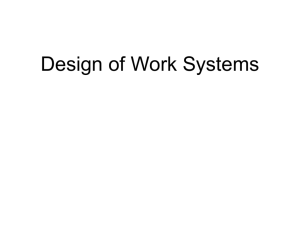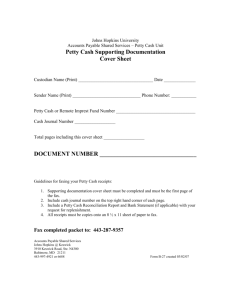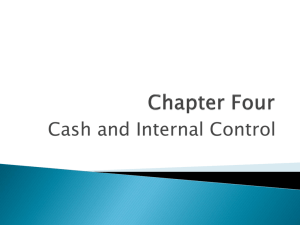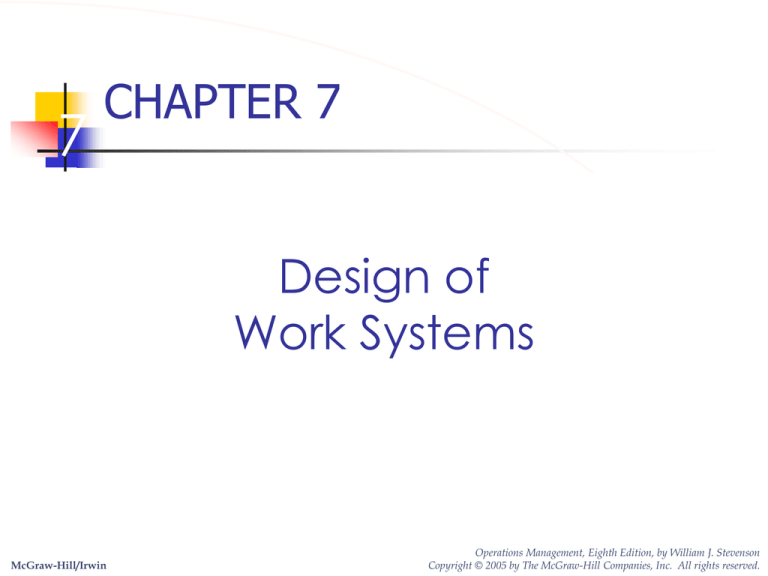
7
CHAPTER 7
Design of
Work Systems
McGraw-Hill/Irwin
Operations Management, Eighth Edition, by William J. Stevenson
Copyright © 2005 by The McGraw-Hill Companies, Inc. All rights reserved.
Major Factors Affecting
Productivity
Technological Development and Raw
Materials
Employees’ Job Performance
Ability
Motivation
Motivational Theories (Theory X, Theory
Y, and Theory Z)
Technological Development
and Raw Materials
Technology
Materials
Plant Layout
Job Designs
Employees’ Job Performance
Ability
Skills
Training
Experience
Knowledge
Education
Employees’ Job Performance
Motivation
Economic Motivators
Individual’s Needs
Hierarchy of Needs
Formal Organization
Organization Structure
Leadership Climate
Personnel Policies
Motivation
Informal
Organization
Size
Goals
Cohesiveness
Leadership
Type of
Leadership
Autocratic
Close
Supervison
Democratic
General
Supervision
Motivation
Union
Cohesiveness
Goals
Leadership
Maslow’s Hierarchy of Needs
Achievement, Creativity,
SELF
Development &
FULFILLMENT Advancement
Self-respect,
EGO
Recognition,
Prestige, Status
SOCIAL
SECURITY
PHYSICAL
Friendship
Shelter &
Protection
Hunger,
Thirst,
Sex
Theory X
People lack motivation
People are basically lazy
People only work because they have to
Theory Y
People are interested in goal
accomplishments
People have the potential for creativity
People have many skills and potentials
Theory Z
William G. Ouchi’s
This theory explores the differences between
the Japanese and American management
systems.
Japanese system is designated as J type
American system is designated as A type
U.S. organizations that have some
characteristics of the Japanese organizations
as Z type
Examples: IBM, Eastman-Kodak, Hewlett-Packard
Theory Z
Characteristics of Z type organizations
Employment must be stabilized
This means employment security
Unions must be involved but not in an
adversary relationship
A system for slow evaluation and
promotion should be developed
Job Design
Job design involves specifying the
content and methods of job
What will be done
Who will do the job
How the job will bob will be done
Where the job will be done
Ergonomics
Design of Work Systems
Specialization
Behavioral Approaches to Job Design
Teams
Methods Analysis
Motions Study
Working conditions
Job Design Success
Successful Job Design must be:
Carried out by experienced personnel
with the necessary training and
background
Consistent with the goals of the
organization
In written form
Understood and agreed to by both
management and employees
Specialization in Business:
Advantages
For Management:
For Labor:
1. Simplifies training 1. Low education and
2. High productivity
3. Low wage costs
skill requirements
2. Minimum
responsibilities
3. Little mental effort
needed
Disadvantages
ForManagement:
ForLabor:
1. Difficult to motivate
quality
1. Monotonous work
2. Limited opportunities
for advancement
2. Worker dissatisfaction,
possibly resulting in
3. Little control over work
absenteeism, high
4. Little opportunity for
turnover, disruptive
self-fulfillment
tactics, poor attention
to quality
Behavioral Approaches to Job
Design
Job Enlargement
Job Rotation
Giving a worker a larger portion of the total
task by horizontal loading
Workers periodically exchange jobs
Job Enrichment
Increasing responsibility for planning and
coordination tasks, by vertical loading
Motivation and Trust
Motivation
Influences quality and productivity
Contributes to work environment
Trust
Influences productivity and employeemanagement relations
Teams
Benefits of teams
Higher quality
Higher productivity
Greater worker satisfaction
Self-directed teams
Groups of empowered to make certain
changes in their work process
Methods Analysis
Methods analysis
Analyzing how a job gets done
Begins with overall analysis
Moves to specific details
Methods Analysis
The need for methods analysis can come
from a number of different sources:
Changes in tools and equipment
Changes in product design
or new products
Changes in materials or procedures
Other factors (e.g. accidents, quality
problems)
Methods Analysis Procedure
Identify the operation to be studied
Get employee input
Study and document current method
Analyze the job
Propose new methods
Install new methods
Follow-up to ensure improvements
have been achieved
Analyzing the Job
Flow process chart
Chart used to examine the overall
sequence of an operation by focusing on
movements of the operator or flow of
materials
Worker-machine chart
Chart used to determine portions of a
work cycle during which an operator and
equipment are busy or idle
FLOW PROCESS CHART
ANALYST PAGE
Job Requisition of petty cash D. Kolb 1 of 2
Details of Method
Requisition made by department head
Put in “pick-up” basket
To accounting department
Account and signature verified
Amount approved by treasurer
Amount counted by cashier
Amount recorded by bookkeeper
Petty cash sealed in envelope
Petty cash carried to department
Petty cash checked against requisition
Receipt signed
Petty cash stored in safety box
Motion Study
Motion study is the systematic
study of the human motions used
to perform an operation.
Motion Study Techniques
Motion study principles - guidelines for
designing motion-efficient work procedures
Analysis of therbligs - basic elemental
motions into which a job can be broken
down
Micromotion study - use of motion pictures
and slow motion to study motions that
otherwise would be too rapid to analyze
Charts
Developing Work Methods
Eliminate unnecessary motions
Combine activities
Reduce fatigue
Improve the arrangement of the
workplace
Improve the design of tools and
equipment
Working Conditions
Temperature &
Humidity
Illumination
Ventilation
Color
Working Conditions (cont’d)
Noise & Vibration
Work Breaks
Safety
Causes of Accidents
Work Measurement
Standard time
Stopwatch time study
Historical times
Predetermined data
Work Sampling
Compensation
Time-based system
Compensation based on time an employee
has worked during a pay period
Output-based (incentive) system
Compensation based on the amount of
output an employee produces during a
pay period
Form of Incentive Plan
Accurate
Easy to apply
Consistent
Easy to understand
Fair
Compensation
Individual Incentive Plans
Group Incentive Plans
Knowledge-Based Pay
System
Management Compensation
Learning Curves
Learning curves: the time
required to perform a task
decreases with increasing
repetitions
Time per repetition
Learning Effect
Number of repetitions
Time per unit
Learning with Improvements
Average
Time
Improvements may create a
scallop effect in the curve.
Applications of Learning
Curves
Manpower planning and scheduling
Negotiated purchasing
Pricing new products
Budgeting, purchasing, and inventory
planning
Capacity Planning
Time/cycles
Worker Learning Curves
A (underqualified)
B (average)
Standard time
C (overqualified)
One week
Training time
Cautions and Criticisms
Learning rates may differ from
organization to organization
Projections based on learning curves
should be viewed as approximations
Estimates based the first unit should
be checked for valid times
Cautions and Criticisms
At some point the curve might level off
or even tip upward
Some improvements may be more
apparent than real
For the most part, the concept does not
apply to mass production

